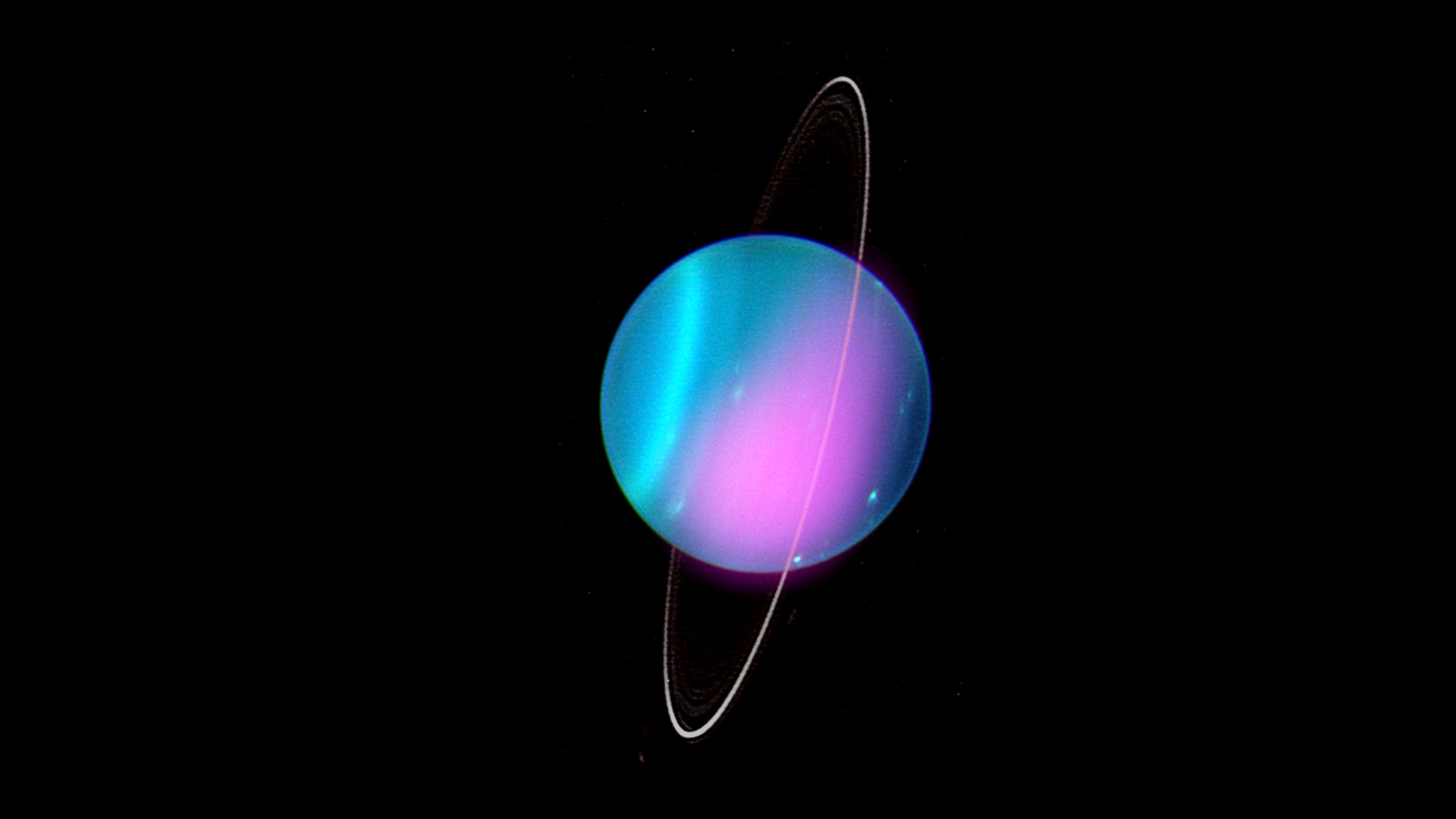Gas giants: Jovian planets of our solar system and beyond
Our gas giants – Jupiter, Saturn, Uranus and Neptune – are helping us find out more about Jovian worlds further away.
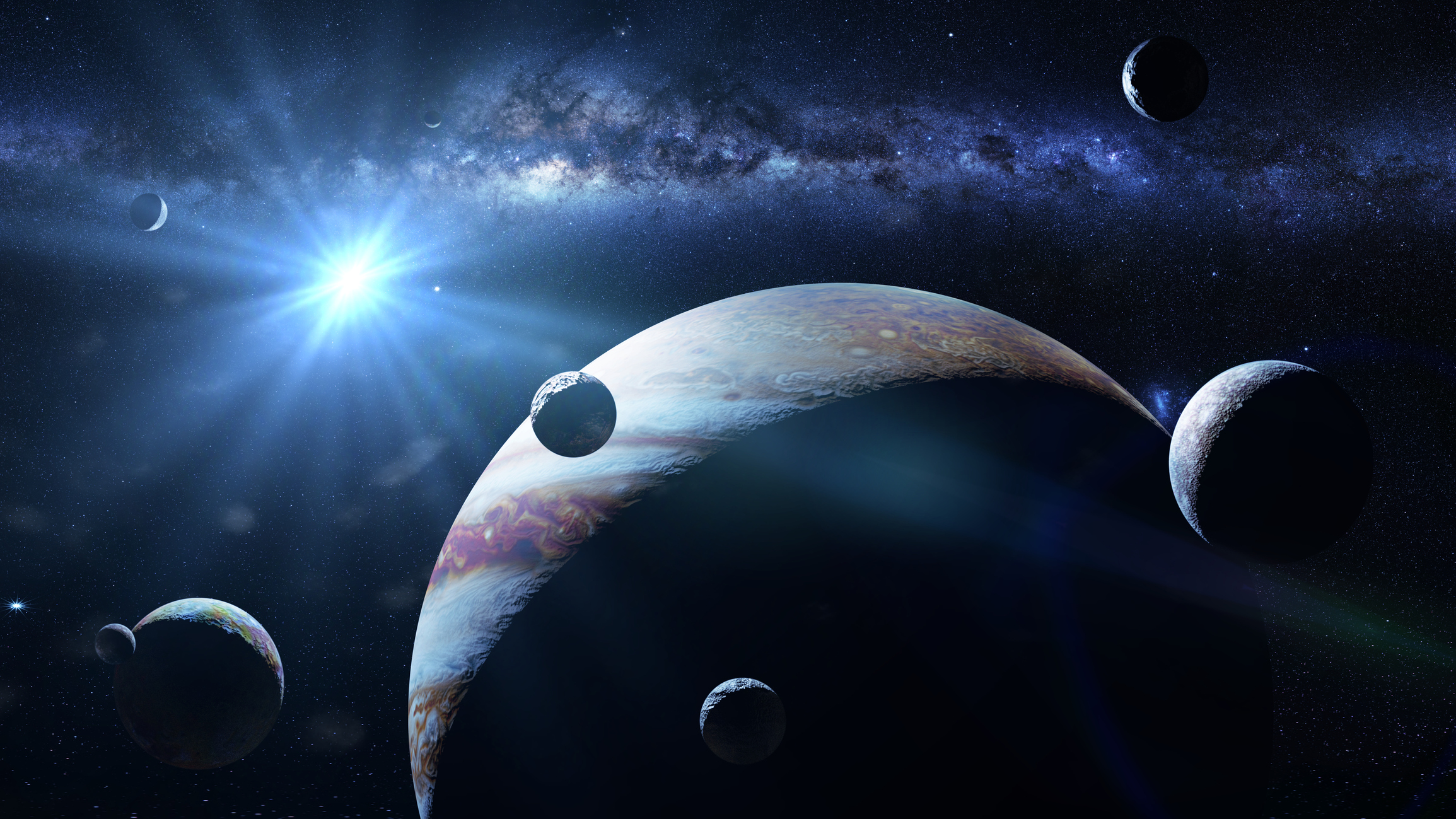
Gas giants are large planets composed mostly of gases, such as hydrogen and helium, with a relatively small rocky core. The gas giants of our solar system — Jupiter, Saturn, Uranus and Neptune — together make up a group known as the Jovian planets, according to the University of Colorado at Boulder.
The term Jovian means “Jupiter-like” and although our exploration of the solar system has revealed that gas giants such as Uranus and Neptune are very different from Jupiter, the descriptive term Jovian still exists. The label is also used to describe Jupiter-mass exoplanets found beyond our solar system according to Swinburne University of Technology.
The solar system's four gas giants reside in outskirts, past the orbits of Mars and the asteroid belt. But the worlds are quite distinct from one another. Jupiter and Saturn are substantially larger than Uranus and Neptune, and each pair of planets (Jupiter and Saturn, vs. Uranus and Neptune) has a somewhat different composition.
Although there are only four large planets in our solar system, astronomers have discovered thousands outside of it using numerous telescopes on Earth and in space. These exoplanets (as they are called) are being examined to learn more about how our solar system came to be, and to compare the formation of our solar system to those planetary systems that might be quite different.
Gas giants' importance
It appears that one of the first uses of the word "gas giant", to refer to a large planet, arose in a 1952 science fiction piece by author James Blish. At the time Blish wrote, no planet had yet been discovered outside of our solar system, nor were any spacecraft yet lifting off from Earth.
This meant that in his era, everything we knew about the planets came from telescopic observations, astronomical theories and datasets just beginning to be parsed by the emerging computer models available at the time. It would take decades before more information came to light.
The first flyby of Jupiter took place in 1972 with Pioneer 10, while the first exoplanets were discovered around pulsar PSR 1257+12 in 1992. The field of gas giant research has rapidly diversified and widened in the decades since.
Breaking space news, the latest updates on rocket launches, skywatching events and more!
"The study of gas giants' behavior has acquired an increased importance since the detection of many gaseous exoplanets," wrote the peer-reviewed science journal Nature in a summary of research to date in 2016.
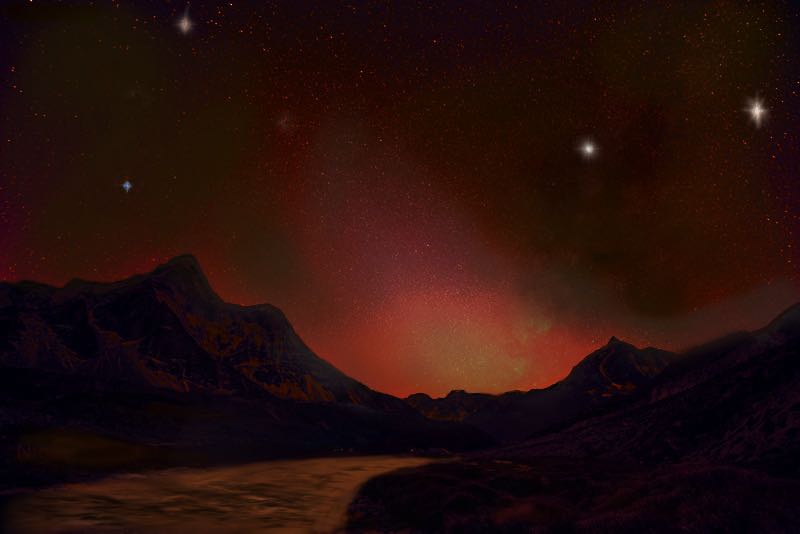
Elements of research that caught scientists' attention in recent years included discussions of gas giant rings, and figuring out the source of auroras. Furthermore, Nature argued, gas giant research will be rich ground for different types of scientists to meet and share their knowledge.
"As many gaseous planets discovered around other stars exhibit significantly different characteristics from the ones in our solar system, science on giant planets has a huge multidisciplinary potential as a meeting point between the planetary and exoplanetary communities," Nature said.
Even since that era, the 2020s have been rich in discoveries thanks to the growing integration of machine learning and artificial intelligence to pursue datasets, not to mention the number of new telescopes seeing first light. Big observatories of the 2020s include the James Webb Space Telescope and the European Extremely Large Telescope, both of which are expected to contribute to studying exoplanets.
Already, too, we have a wealth of exoplanet data from observatories such as NASA's Transiting Exoplanet Survey Satellite (TESS), the agency's retired Kepler space telescope and the High-Accuracy Radial velocity Planet Searcher on the European Southern Observatory's 3.6-meter telescope at La Silla Observatory in Chile. NASA says more than 4,000 exoplanets have been found by early 2022, a large proportion of them gas giants.
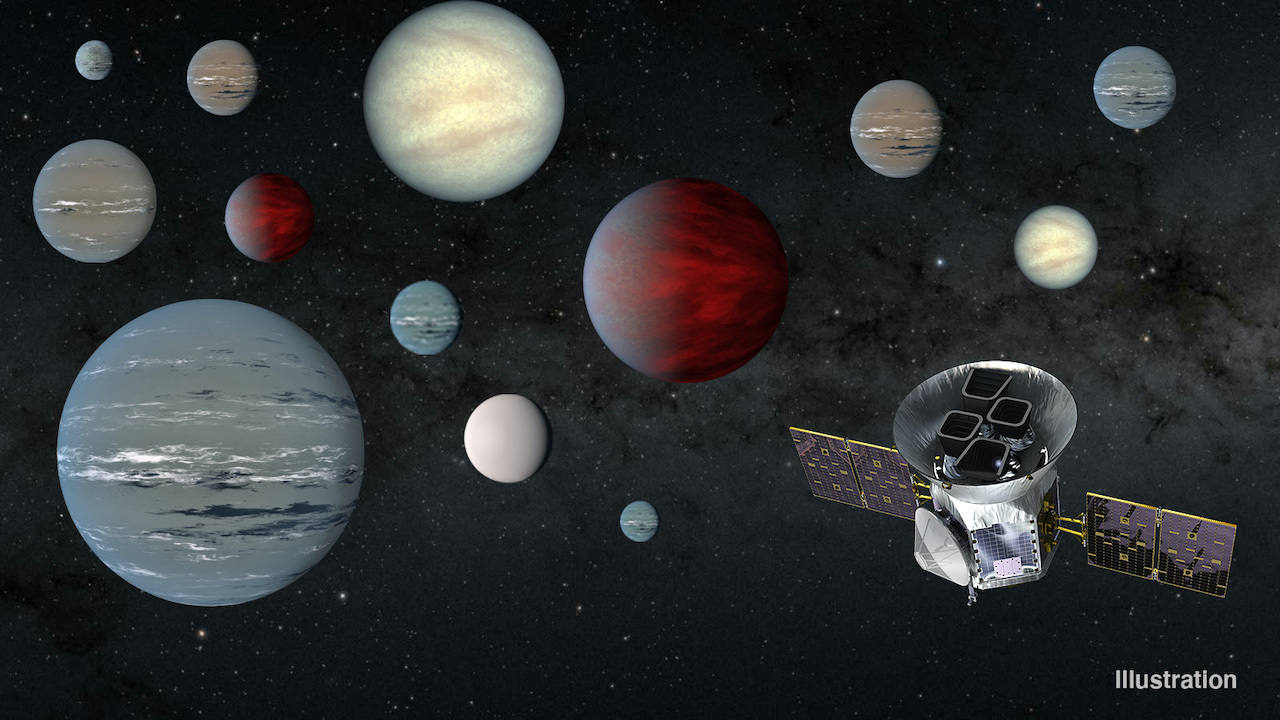
Gas giants in our solar system
Jupiter is the largest planet in our solar system. It has a radius almost 11 times the size of Earth and many dozens of moons either confirmed or waiting to be confirmed. The planet is mostly made of hydrogen and helium surrounding a dense core of rocks and ice, with most of its bulk likely made up of liquid metallic hydrogen, which creates a huge magnetic field. Jupiter is visible with the naked eye and was known to the ancients. Its atmosphere consists mostly of hydrogen, helium, ammonia and methane. We've also rounded up Jupiter's unanswered questions to get a sense of future research, such as how it got enriched with heavy elements.
Saturn is about nine times Earth's radius and is characterized by large rings; how they formed is unknown. It has several dozen moons discovered and being confirmed. Like Jupiter, Saturn is mostly made up of hydrogen and helium that surround a dense core and was also tracked by ancient cultures. Its atmosphere is similar to Jupiter's. We've also looked at some of Saturn's unanswered questions, such as how long a day is on the planet.
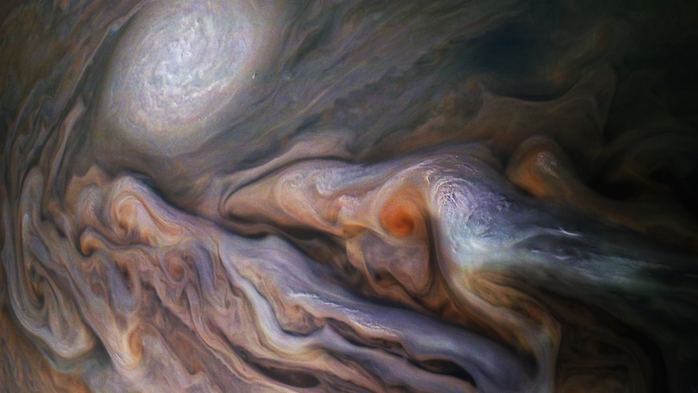
Uranus has a radius about four times that of Earth's and is the first gas giant to be discovered using a telescope, as Jupiter and Saturn have been observed by the naked eye since ancient times. Uranus is the only planet tilted on its side, and it also rotates backward relative to every planet but Venus, implying a huge collision disrupted it long ago. The planet has dozens of moons, and its atmosphere consists of hydrogen, helium and methane. It was discovered by William Herschel in 1781 and only one spacecraft, Voyager 2, flew by it in 1986. Some weird things observed at Uranus include its unexplained cold temperatures, and its complex atmosphere.
Neptune also has a radius about four times that of Earth's. Like Uranus, its atmosphere is mostly made up of hydrogen, helium and methane. It was discovered in 1846 and had a single spacecraft fly by, which was Voyager 2 in 1989. There are more than a dozen confirmed moons at the planet. We've also looked at some of Neptune's biggest mysteries, such as its ultra-high wind speeds. Scientists are also hoping to put together a mission to visit both Uranus and Neptune in a few decades.

Gas giants outside our solar system
Super-Earths: Scientists have found a multitude of "super-Earths" (planets between the size of Earth and Neptune) in other solar systems. There are no known super-Earths in our own solar system, although some scientists speculate there may be a "Planet Nine" lurking in the outer reaches of our solar system. Scientists are studying this category of planets to learn whether super-Earths are more like small gas giant planets or big terrestrial planets. It is also unclear whether these planets can host life, and how much water would be on their surfaces.
Hot Jupiters: These are Jupiter-sized or larger planets that orbit very close to their parent stars. How they got there is still being studied, but the two main theories (simply put) say they either migrated to that orbit from further away, or that they formed essentially in place. These exoplanets were the first to be found because they are so massive and so close to their parent stars that they induce large "wobbles" in the star's gravity, which made them relatively easy to spot with observatories of the 1990s, according to NASA.

Formation and chances for life
Astronomers think Jovian planets first formed as rocky and icy planets similar to terrestrial planets. However, the size of the cores allowed these planets (particularly Jupiter and Saturn) to grab hydrogen and helium out of the gas cloud from which the sun was condensing, before the sun formed and blew most of the gas away.
Since Uranus and Neptune are smaller and have bigger orbits, it was harder for them to collect hydrogen and helium as efficiently as Jupiter and Saturn. This likely explains why they are smaller than those two planets. On a percentage basis, their atmospheres are more "polluted" with more complex chemical compounds such as methane and ammonia because they are so much smaller.
Gas giants are unlikely to host life as we know it, as they are huge balls of gas with no substantial surface. That said, there is a possibility of finding microbial life at their various icy moons, or perhaps there are other possibilities of life that science has not yet considered. But as of 2021, even smaller, Earth-sized planets we have found are very unlikely to host life, a major study concluded.
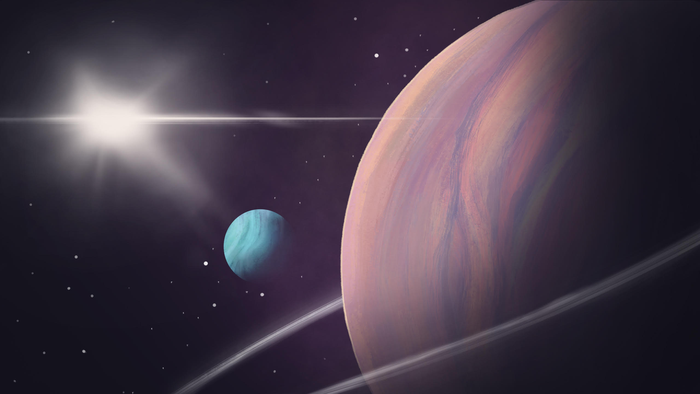
Gas giant's moons
There are dozens of moons around the giant planets in our solar system. Many formed at the same time as their parent planets, which is implied if the planets rotate in the same direction as the moons close to their equator (such as the huge Jovian moons Io, Europa, Ganymede and Callisto.) But there are exceptions.
One large moon of Neptune, Triton, orbits the planet opposite to the direction Neptune spins — implying that Triton was captured, perhaps by Neptune's once larger atmosphere, as it passed by. And there are many tiny moons in the solar system that rotate far from the equator of their planets, implying that they were also snagged by the immense gravitational pull.
A subset of moons, called icy moons, might have conditions for life as we have found evidence for energy and liquid water that could sustain microbes. NASA's Europa Clipper and the European Space Agency's JUpiter ICy moons Explorer (JUICE) are both planned for the 2030s to learn more about several moons' potential for life. There are also hopes to have a landing mission at a Jovian moon (or at some other icy moon elsewhere in the solar system) later in the century to see the surface up close.
As of early 2022, the astronomical community hasn't definitely confirmed a detection of an exomoon, a moon orbiting an exoplanet. But they are getting closer. To detect an exomoon, we need to see not only the dip in brightness caused when a planet passes in front of a star, but also a distinctive dip from the moon. Moons are relatively tiny and difficult for our current observatories to spot. But telescope technology is fast improving so astronomers might soon be lucky.

Ongoing research
With so many active missions in progress or in planning for these various worlds, not to mention telescope studies and computer models, the science of gas giants can change rapidly in a matter of weeks or months. We will point here to general research directions, along with Space.com pages where you can stay up to date on the latest findings from the various gas giants in and out of the solar system.
Jupiter: NASA's Juno spacecraft arrived at the planet in 2016, adding to numerous other studies by spacecraft and the Hubble Space Telescope. It has studied the planet's rings, which is difficult to achieve otherwise since they are far subtler than Saturn's. The probe delves into the auroras of Jupiter to learn about their source and differences from other planets, and dives deep into the atmosphere to learn about clouds within the planet's atmosphere. Researchers are also fascinated with the behavior of the Great Red Spot, a persistent storm system in Jupiter's Southern Hemisphere, which appears to be shrinking. Keep up to date on Jupiter research here.
Saturn: The Cassini spacecraft wrapped up more than a dozen years of observation at Saturn in 2017. But the science Cassini performed is still very much in progress, as scientists analyze data collected during its many years at Saturn. Its rings have been used to probe the planet's gravity, and scientists are quite interested in the various icy moons around the planet that may host life. Keep up to date on Saturn research here.
Uranus: The storms of Uranus are a frequent target for both professional telescopes and amateur astronomers, who monitor how they evolve and change over time. Scientists are also interested in learning about the structure of its rings, and what its atmosphere is made of. Recent studies have focused on aspects such as weather in its atmosphere, and Trojan asteroids surrounding the planet. Keep up to date on Uranus research here.
Neptune: Storms on Neptune are also a popular observing target, and in 2018 those observations again bore fruit; work from the Hubble Space Telescope showed that a long-standing storm is now shrinking. The researchers noted the storm is dissipating differently than what their models expected, which shows that our understanding of Neptune's atmosphere still requires refinement.
Exoplanets: Our search for exoplanets is really just beginning, but as the dataset grows ever larger, NASA aims address these big-scale questions: What is an exoplanet? Is there life on other planets? How many exoplanets are there? Finally, where can we find exoplanets and can we predict their locations? And as mentioned earlier, the search for exomoons continues. Stay tuned to Space.com for exoplanet news and also review our 2021 biggest exoplanet discoveries for more information.
Additional resources:
Learn more about gas giants and Jovian planets in more detail with NASA. Read about how supercritical fluids could help us understand the interior of giant gas planets with this article published in The Conversation. Explore the outer planets with this informative resource from the educational website Lumen Learning.
Bibliography
"Gas Giant." NASA. (2021, March 22.) https://exoplanets.nasa.gov/what-is-an-exoplanet/planet-types/gas-giant/
"Gas Giant." Science Fiction Dictionary. (2020, Dec. 16). https://sfdictionary.com/view/52/gas-giant
"The Search For Life." NASA. (2020, Dec. 8). https://exoplanets.nasa.gov/search-for-life/big-questions/
"Advances in Planetary Science." Nature. (2016, Oct. 4). https://www.nature.com/collections/bphtvvsswf/gasgiants
Trifonov, Trifon, et al. "Two Jovian planets around the giant star HD 202696: A growing population of packed massive planetary pairs around massive stars?." The Astronomical Journal 157.3 (2019): 93.
Jones, M. I., et al. "Four Jovian planets around low-luminosity giant stars observed by the EXPRESS and PPPS." Astronomy & Astrophysics 646 (2021): A131.

Elizabeth Howell (she/her), Ph.D., was a staff writer in the spaceflight channel between 2022 and 2024 specializing in Canadian space news. She was contributing writer for Space.com for 10 years from 2012 to 2024. Elizabeth's reporting includes multiple exclusives with the White House, leading world coverage about a lost-and-found space tomato on the International Space Station, witnessing five human spaceflight launches on two continents, flying parabolic, working inside a spacesuit, and participating in a simulated Mars mission. Her latest book, "Why Am I Taller?" (ECW Press, 2022) is co-written with astronaut Dave Williams.
- Daisy DobrijevicReference Editor
